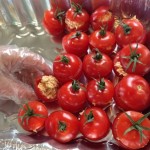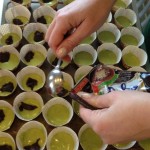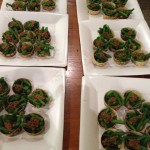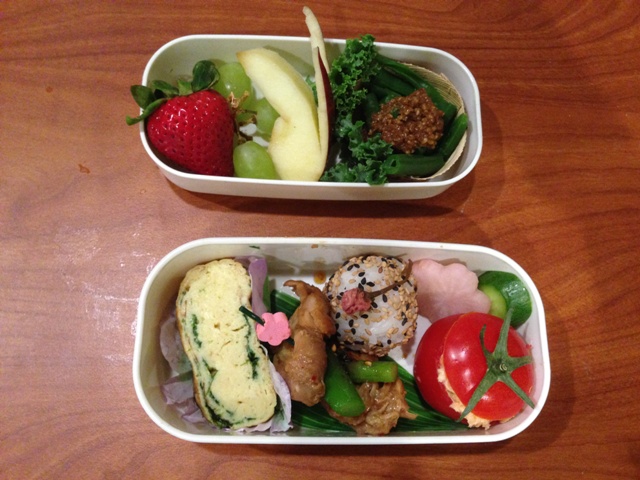02 Apr / Happy Bento “Box-ing”
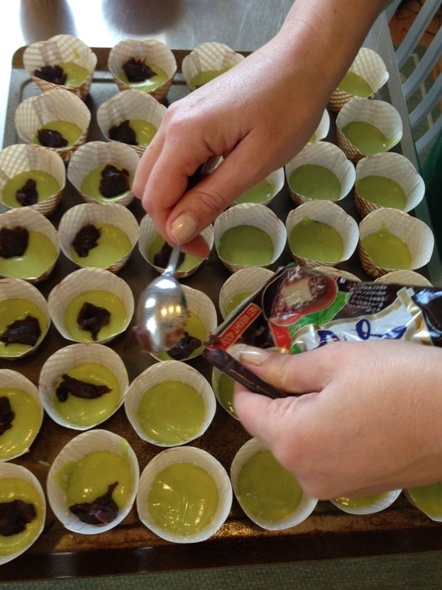
A few weeks ago, my food writer friend Debra Samuels (co-author of The Korean Table and author of My Japanese Table, both by Tuttle Publishing) came to Washington D.C. to do a bento box demonstration with the Smithsonian Associates.
Deb and I have only communicated via email and social media, but when I heard she was coming to town, I eagerly volunteered to help. I was delighted to discover that Deb is every bit as lovely in person!
We spent the day of the event (we were expecting 150 people!) prepping, prepping, and prepping.
Here is a slideshow with some highlights:
- Tomatoes were hollowed out and stuffed with tuna salad
- Filling matcha cupcakes with red bean paste
- Salted cherry blossoms had to be rinsed of excess salt and dried before decorating onigiri (rice balls)
- Green beans with sesame sauce
- A completed bento box made by one of the attendees
I’m sure many of you are dying to try your hand at bento “box-ing” so I asked Debra to give us some guidance on putting one together. Note that her focus is on kids’ bento boxes.
1. What are the most important elements of a bento box?
- It’s all about balance and using foods that span 5 different colors: red, black/brown, white, green, yellow. With those colors it is deemed that you have a balanced meal
- Have a variety of foods, whether in texture, cooking methods (boiled, stir-fry, fried) as well as types of food
- Make it visually pleasing
- Pay attention to nutritional value and portion sizes. Have smaller amounts of each food but a greater variety (see above, they are closely linked)
- And my Japanese friends say “LOVE” is in the box
- Usually rice or a carbohydrate (bread or pasta are fine too!) takes up to at least 1/3 of the box for a girl and up to half for a boy
- Protein is also important. Sometimes boys will get 2 kinds of protein
- Otherwise, meat, fish and chicken are often seen as okazu–side dishes–so they share equally in portion size with vegetables, fruit, etc.
2. What tips can you share with us newbies?
- Look at a bento box as a food sampler of sorts
- Concentrate on the colors
- Have a few neat picks so that you can create a kabob, for example: skewer a turkey meatball, steamed broccoli and a cherry tomato and brush all with a glaze of teriyaki sauce (find cute picks and more bento accessories on Amazon.com!)
- View this as a good opportunity to give your child some new foods in smaller amounts
- Stock up on silicon cups and put mini salads in them: pasta, leafy greens
- Prepare ahead of time: Have several (see-through) containers of precut and cooked veggies, corkscrew pasta, cut fruit, mini-meatballs
- Good leftovers equal a good lunch so make more than you need for dinner. The point is to re-fashion it creatively
- Definitely add a small treat (try Deb’s matcha mochi cupcakes below)
- For me, there are almost no ‘no-no’s.
3. What’s the difference between an adult’s and a kid’s bento box?
Mainly the difference is volume. There are also differences in volume between bento boxes for men and women. Men’s boxes have an interior space that can contain about 30% more food. Also the types of food that go into the box could be heavier on protein and carbs for men, and more fried foods as well.
As far as presentation is concerned, it still has to be pleasing to the eye. The Japanese say “me de taberu” they eat with their eyes. The same care is given to a 5-year-old’s lunch as is to a 15 or 50-year- old. A bento box for an adult may be less cute, but it will still be attractive.
For more info and tips, please visit Deb’s site: Cookingatdebras.com
Happy bento “box-ing”!
~~~
Matcha Mochi Cupcakes
From My Japanese Table (Tuttle Publishing, 2011) by Debra Samuels
“Thai sweet rice (glutinous) flour doesn’t work in this recipe. The best results are with Koda Farms Mochiko. I first learned about mochi cupcakes when a Boston friend who is married to a Japanese-American man. She got the recipe from her mother-in-law’s Buddhist Temple Community cookbook from Los Angeles. It has since been tweaked several times by other cooks.” ~ Debra
Makes about 16
3 cups (one 1-pound box) Koda Farms Mochiko (sweet rice flour, available at Asian Markets and some Whole Foods Markets)
2 teaspoons baking powder
1/4 teaspoon salt
2 teaspoons matcha (green tea powder)
3/4 cup canola oil
1 cup sugar
3 eggs
1 1/2 cups milk
1 can (15 ounces) sweet adzuki beans (optional)
Set the oven at 375 degrees F. Line a muffin tin with paper or foil cups.
In a bowl, combine the rice flour, baking powder, salt, and green tea. Whisk well.
In another larger bowl, mix the oil and sugar. Add the eggs and milk and whisk vigorously.
Add the rice flour mixture and mix with a rubber spatula until completely blended.
Fill the cupcake papers half full with the batter. Add a scant tablespoon of the adzuki beans. Spoon a little more batter over the beans. This should come just below the tops of the papers.
Bake the cupcakes for 20 to 25 minutes or until they begin to crack. Set on a wire rack to cool.






